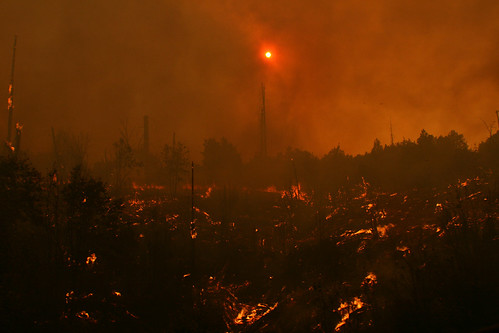
Like a phoenix rising from ashes, blackened portions of the Stanislaus National Forest, which were left by the Rim Fire that blazed through the Sierras in August of 2013, have begun to spring to life. Left with a burn scar that is one-third larger than New York City, a reforestation team is diligently working to bring forth a new forest.
Since the fire, much has been done in the way of making the forest safe for public travel and recreation along main travel routes. Snags and fire-damaged trees present significant safety hazards to humans. They also create a tremendous fuel load on the ground (biomass) as they fall. This fuel can feed future fires, which can be severely damaging to the soil.
Thus far, many thousands of burned trees have been removed via salvage logging. Logging not only allows the wood to be repurposed, but it also clears the path for the future forest and the animals that will inhabit it.
The next step in this restoration process is reforestation. Maria Benech, Interdisciplinary Team Leader for the Rim Fire Reforestation project, has been working with a host of scientists, resource specialists and the public to develop a project plan for the future forest.
Without intervention, it could take several decades, even centuries, for the forest to reestablish its place in the natural cycle. The intensity and sheer size of the fire left large gaps in the forest canopy. These gaps are far greater than those historically seen.
“Seed-producing trees are so far away from some of these openings that it is very unlikely trees could naturally regenerate for a very long time,” said Benech.
Biodiversity, wildlife habitat and fire resiliency are priorities driving the reforestation plan.
“We are looking about 60 to 100 years into the future to picture our end goal,” said Benech. “That includes incorporating information on forest resiliency to fire, historic forest structure and climate change models.”
The project lists the following needs:
1) return a mixed conifer forest to the landscape;
2) restore mature forest for wildlife habitat and connectivity;
3) reduce fuels for future fire resiliency;
4) enhance deer habitat; and
5) eradicate noxious weeds.
Creating a forest that can adapt and survive natural disturbances is also important. That is why the reforestation plan calls for thinning of 11,285 acres of existing plantations.
“Forests in California need to be able to bounce back following disturbance, and fire is a natural and critical agent of change,” said Jeanne Higgins, forest supervisor for the Stanislaus National Forest. “Removing fire from the equation is not part of the plan, but reducing the intensity of future forest fires certainly is a part of our overall mission. Thinning will help us to reach that desired resilient state.”
“Reintroducing fire into the forested areas early is one way the Stanislaus has of lessening the damaging effects of intense fires,” said Chris Schow, fire management officer. “Frequent fires tend to burn with less severity and the post-fire effects are less damaging because there is less fuel to drive up the intensity.”
The Rim Fire killed conifers that were shading out many of the large oaks that once thrived on this landscape when fire was more frequent. Without competition, these oaks, which readily re-sprout from their bases, are rebounding in the burned area.
The reforestation plan takes into account the importance of oak trees and is recommending seedlings are not planted within a 25-foot buffer of these re-sprouting trees.
“Acorns are such an important food crop for so many species of wildlife,” said Marcie Baumbach, forest wildlife biologist. “That’s partly why we are doing things differently this time.”
Deer are one species that rely on acorns during cold winter months. They are also an indicator species for overall forest health, and have been studied by some of California’s earliest visitors. Current studies conducted by the California Department of Fish and Wildlife indicate that migratory deer herds are on the decline statewide.
Migratory deer, such as the Tuolumne deer herd, travel mountainous corridors between higher and lower elevations in the Sierra Nevada. Downed timber from the Rim Fire interrupted some of these travel corridors. It also disrupted habitat critical to their survival.
Enhancing wildlife habitat is just one aspect of this multi-faceted project. The reforestation plan is a road map for the future that highlights a variety of resource issues.
The public is welcome to attend upcoming reforestation events.

